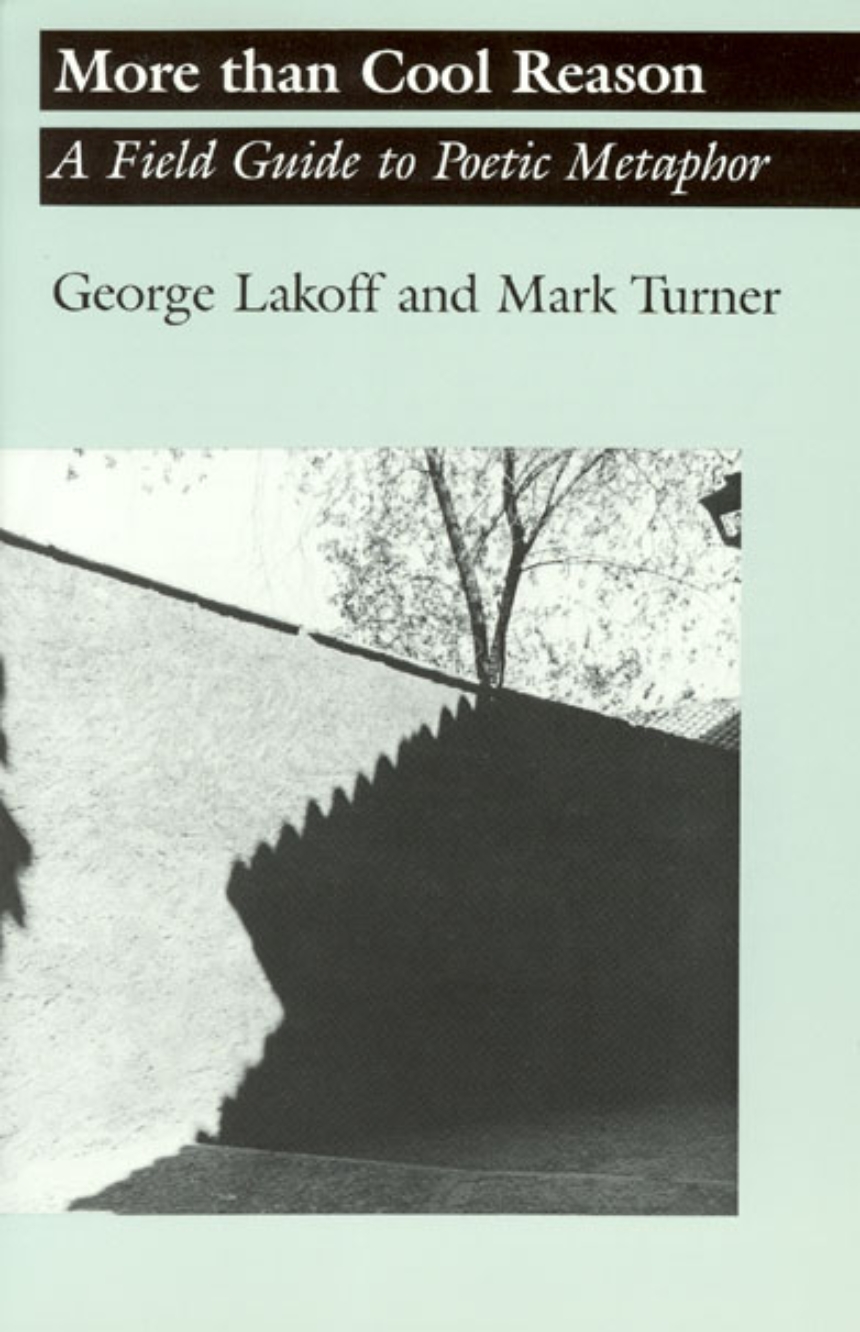More than Cool Reason
A Field Guide to Poetic Metaphor
We usually think of the language of poetry, the metaphors that poets use to express their intentions, as far removed from ordinary life. But in More than Cool Reason, George Lakoff and Mark Turner show how understanding how metaphor works in poetry, the tasks it takes on and the ways it shapes our patterns of thought, can be hugely helpful to seeing and understanding how we think in all manner of other fields and areas of life. Metaphor, they show, is a tool so familiar, so everyday, that we fail to notice it. Lakoff and Turner correct that failure here, helping us see how richly metaphorical our language and thought are, and what that means for not only reading and enjoying poetry and literature, but also for linguistics, philosophy, psychology, anthropology, cognitive science, and more.
237 pages | 5.50 x 8.50 | © 1989
Language and Linguistics: General Language and Linguistics, Philosophy of Language
Reviews
Table of Contents
Excerpt
Metaphors are so commonplace we often fail to notice them. Take the way we ordinarily talk about death. The euphemism "He passed away'' is not an arbitrary one. When someone dies, we don't say "He drank a glass of milk'' or "He had an idea'' or "He upholstered his couch.'' Instead we say things like "He's gone,'' "He's left us,'' "He's no longer with us,'' "He's passed on,'' "He's been taken from us,'' "He's gone to the great beyond,'' and "He's among the dear departed.'' All of these are mundane, and they are metaphoric. They are all instances of a general metaphorical way we have of conceiving of birth, life, and death in which BIRTH IS ARRIVAL, LIFE IS BEING PRESENT HERE, and DEATH IS DEPARTURE. Thus, we speak of a baby being "on the way'' and "a little bundle from heaven,'' and we send out announcements of its "arrival.'' When Shakespeare's King Lear says
Thou must be patient; we came crying hither:Thou know'st the first time that we smell the air
We waul and cry . . . (King Lear, 4.4)
he is using an extension of the very ordinary metaphorical conception of birth as arrival ("came hither'') that we use when we speak of a baby being on the way. Mark Twain said he Twain, Mark "came in'' with Halley's comet and would "go out'' with it--and we all understand that he was talking about birth and death. To speak of someone, after a serious operation, as being "still with us'' is to say he is alive, with the "still'' suggesting the possibility of imminent departure. Someone who is "at Death's door'' can be spoken of as "slipping away.'' If a patient's heart stops beating and a doctor gets it started again, the doctor can describe this as "bringing him back.'' And if a doctor, after an operation, emerges from the operating room and says "We lost him,'' then we know the patient died, because something that is lost is absent.
All this may seem obvious, but there is an important theoretical issue at stake in these examples: metaphor resides in thought, not just in words. There is a metaphorical conception of death as departure that can be expressed in many different ways, such as "passing away,'' "being gone,'' and "departing.'' Though we would not normally speak of a coachman coming to take away someone who is dying, we nonetheless normally conceive of death as a departure and speak of it that way. And when Emily Dickinson speaks of Death as a coachman, she is using an extension of the same general and ordinary metaphorical conception of death as departure that we use when we speak of someone passing away.
We use the death-as-departure metaphor in making sense of Dickinson's poem. We can see this by noticing that nowhere in the first four lines is anything said about departure with no return. And yet we know when she says, "The Carriage held but just ourselves'' that the passengers are not simply sitting in the carriage or going for a visit or a spin around the block. We know because we understand death as a departure with no return. Because we conceive of death in this way, Dickinson does not need to state all of the details: we know them by virtue of knowing the basic conceptual metaphor.
Life and death are such all-encompassing matters that there can be no single conceptual metaphor that will enable us to comprehend them. There is a multiplicity of metaphors for life and death, and a number of the most common ones show up in the Dickinson poem. To begin to sort them out, let us return to the line "Because I could not stop for Death--.'' We understand here that what the speaker cannot stop are her purposeful activities. A purposeful life has goals, and one searches for means toward those goals. We conceive metaphorically of purposes as destinations and of the means to those destinations as paths. We speak of "going ahead with our plans,'' "getting sidetracked,'' "doing things in a roundabout way,'' and "working our way around obstacles.'' Thus there is a common metaphor PURPOSES ARE DESTINATIONS, and such expressions are instances of it.
